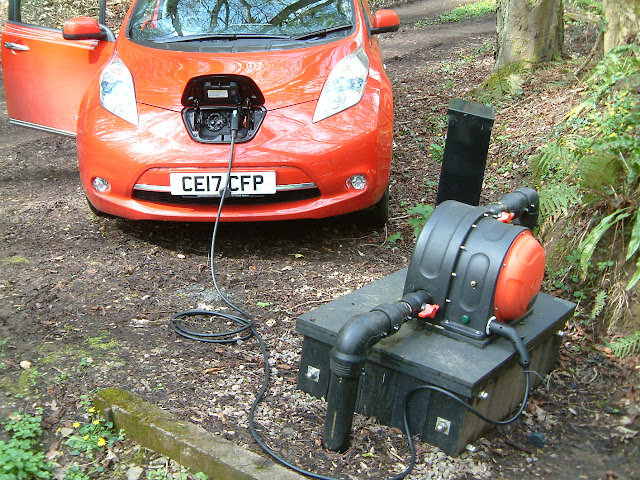The explanation behind such an unprecedented level of generation is that I've been waiting for a time when there was copious flow so I could run some tests to check what the system efficiency is at the top end of the range of flows I see at my site. To do this I have had to run the installation a little beyond the limits imposed by the various authorities that licence small hydros: strictly the output should not exceed 750 W and the maximum flow 3 l/s.
Previously in this blog, I presented a plot like the one below to illustrate how operating with one jet in the bottom position was more efficient than operating with both jets:
With the data I had at that time, the plot seemed to show there was a clear advantage to using only one jet and in the bottom position - it gave an improvement in system efficiency of about 2 %, and this advantage seemed to apply throughout the flow range, - although it should be noted that data points for single jet operation are sparse for higher flows, there being only one.
Having copious water available at the moment, it has been possible to get data readings for the larger nozzles very easily, and this has meant I've been able to fill in the gaps in the earlier data series and better define what happens at the top end of the flow range. The resulting plot, which is based on a completely new data set, now looks slightly different:
... it will be seen that when a very large single jet is employed, one that delivers 3.12 l/s, the efficiency starts to drop off and begins to fall below the trend line for two jet operation.
I'm not sure why this should be. There shouldn't be any question of water from this bigger nozzle missing the cups on the runner: the cups are 70 mm wide and the diameter of the jet 12.2 mm. Maybe it's just that there's a lot of splash from the force of this big jet and that impairs the efficiency.
Some of the reason for the fall-off in efficiency beyond a flow of 2.5 l/s in both single and two jet operation is that shaft speed begins to rise away from the optimum speed for the runner. I have found that with flows greater than 2.5 l/s I have needed to change from the standard Type 2 rotor to the more strongly magnetised Type 2+ rotor. This keeps the shaft speed down to nearer the optimum speed, which for my site is 1000 +/- 100 rpm. At the moment, generating as I am 892 W from 3.26 l/s, the shaft speed is 1165 rpm. Were I to push the experimenting and deliver even more water to the runner, the downward trajectory of the efficiency curves for both single and double jet operation would fall off steeply as shaft speed began to rise despite the 'braking effect' of the Type 2+ rotor.
As it happens, I don't want to do such an experiment: the inverter I have is a WindyBoy 1200w and for continuous operation (as is the case when the inverter is coupled to a Powerspout) the output rating of 1200 W has to be down-rated to 900W. Not wanting to roast the inverter, I think I'll just stay at 892 W.








































